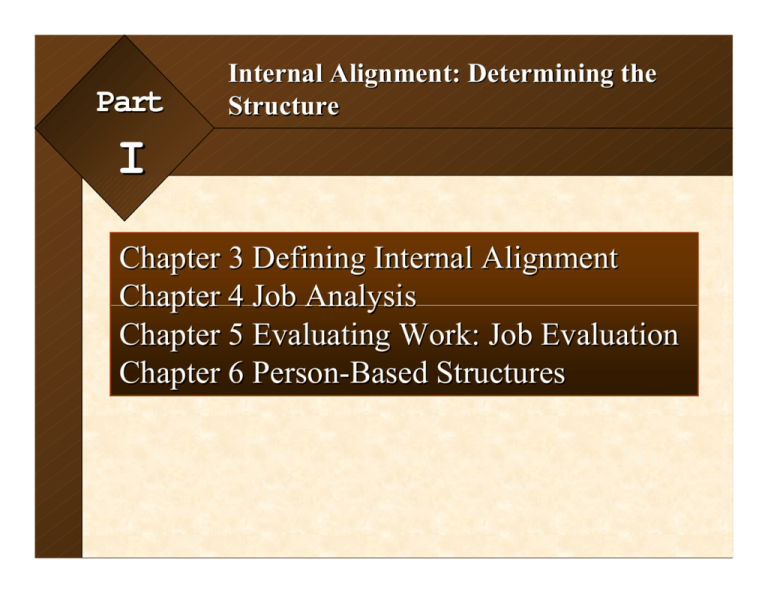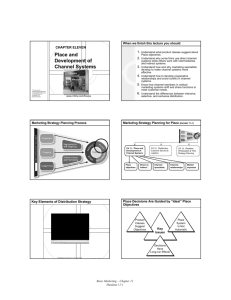
3-1
Part
Internal Alignment: Determining the
Structure
I
Chapter 3 Defining Internal Alignment
Chapter 4 Job Analysis
Chapter 5 Evaluating Work: Job Evaluation
Chapter 6 Person-Based Structures
McGraw-Hill/Irwin
© 2002 by The McGraw-Hill Companies, Inc. All rights reserved.
3-2
STRATEGIC
POLICIES
ALIGNMENT
COMPETITIVENESS
CONTRIBUTORS
STRATEGIC
OBJECTIVES
TECHNIQUES
Work
Descriptions
Analysis
Market
Surveys
Definitions
Seniority
Based
Evaluation/
Certification
Policy
Lines
Performance
Based
Merit
Guidelines
INTERNAL
STRUCTURE
PAY
STRUCTURE
INCENTIVE
PROGRAMS
EFFICIENCY
• Performance
• Quality
• Customers
• Stockholders
• Costs
FAIRNESS
COMPLIANCE
ADMINISTRATION
Planning Budgeting Communication EVALUATION
McGraw-Hill/Irwin
© 2002 by The McGraw-Hill Companies, Inc. All rights reserved.
3-3
Chapter
3
Defining Internal Alignment
McGraw-Hill/Irwin
© 2002 by The McGraw-Hill Companies, Inc. All rights reserved.
3-4
Learning Objectives
After studying Chapter 3, students should be able to:
1.
2.
3.
4.
Explain why internal alignment is an important pay
policy issue and how to evaluate internal alignment.
Discuss the dimensions that comprise a pay structure
and factors that influence it.
Discuss the pros and cons of egalitarian and
hierarchical structures and how they relate to strategy.
Discuss the impact of internal pay structures on
efficiency, equity, and compliance in the pay system.
McGraw-Hill/Irwin
© 2002 by The McGraw-Hill Companies, Inc. All rights reserved.
3-5
Compensation Strategy:
Internal Consistency
Supports Work Flow
Supports Fairness
Directs Behavior Toward
Organization Objectives
McGraw-Hill/Irwin
© 2002 by The McGraw-Hill Companies, Inc. All rights reserved.
3-6
Internal alignment, often called internal
equity, refers to the pay relationships
between the jobs / skills / competencies
within a single organization. The
relationships form a pay structure that can
support the workflow, is fair to
employees, and directs their behavior
toward organization objectives.
McGraw-Hill/Irwin
© 2002 by The McGraw-Hill Companies, Inc. All rights reserved.
3-7
Internal Consistency:
Engineering Job Structure at Lockheed
Entry Level
Engineer: Limited use of basic principles. Close supervision.
Senior Engineer: Full use of standard principles and concepts. Under
general supervision.
Systems Engineer: Wide applications of principles and concepts, plus
working knowledge of other related disciplines. Under very general
direction.
Lead Engineer: Applies extensive knowledge as a generalist or specialist.
Exercises wide latitude.
Advisor Engineer: Applies advanced principles, theories, and concepts.
Assignments often self-initiated.
Recognized
Authority
Consultant Engineer: Exhibits an exceptional degree of ingenuity,
creativity, and resourcefulness. Acts independently to uncover and resolve
operational problems.
McGraw-Hill/Irwin
© 2002 by The McGraw-Hill Companies, Inc. All rights reserved.
3-8
Pay structure, refers to the array of pay
rates for different work or skills within a
single organization. The number of levels,
differentials in pay between the levels, and
the criteria used to determine those
differences create the structure.
McGraw-Hill/Irwin
© 2002 by The McGraw-Hill Companies, Inc. All rights reserved.
3-9
Internal Consistency:
Engineering Pay Structure at Lockheed
Entry Level
Engineer: ($40,000) Limited use of basic principles. Close supervision.
Senior Engineer: ($58,500) Full use of standard principles and concepts.
Under general supervision.
Systems Engineer: ($73,000) Wide applications of principles and concepts,
plus working knowledge of other related disciplines. Under very general
direction.
Lead Engineer: ($93,000) Applies extensive knowledge as a generalist or
specialist. Exercises wide latitude.
Advisor Engineer: ($120,000) Applies advanced principles, theories, and
concepts. Assignments often self-initiated.
Recognized
Authority
Consultant Engineer: ($162,000) Exhibits an exceptional degree of ingenuity,
creativity, and resourcefulness. Acts independently to uncover and resolve
operational problems.
McGraw-Hill/Irwin
© 2002 by The McGraw-Hill Companies, Inc. All rights reserved.
3 - 10
What Shapes Internal Structures?
EXTERNAL
EXTERNAL FACTORS:
FACTORS:
Economic
Economic Pressures
Pressures
Government
Government Policies,
Policies, Laws,
Laws, Regulations
Regulations
Stakeholders
Stakeholders
Cultures
Cultures and
and Customs
Customs
ORGANIZATION FACTORS:
Strategy
HR Policy
Technology
Employee Acceptance
Human Capital
Cost Implications
INTERNAL STRUCTURE:
Levels
Differentials
Criteria
McGraw-Hill/Irwin
© 2002 by The McGraw-Hill Companies, Inc. All rights reserved.
3 - 11
Illustration of an Internal Labor Market
Hire
Consultant
Consultant
Engineer
Engineer
Advisor
Advisor
Engineer
Engineer
Lead
Lead
Engineer
Engineer
Systems
Systems
Engineer
Engineer
Hire
Senior
Senior
Engineer
Engineer
Hire
Engineer
Engineer
McGraw-Hill/Irwin
© 2002 by The McGraw-Hill Companies, Inc. All rights reserved.
3 - 12
Structures Vary
!An internal pay structure is defined by:
!the number of levels of work
!the pay differentials between the levels
!the criteria used to determine those levels
and differentials
!These are the factors that a manager may
vary to design a structure that supports the
work flow, is fair, and directs employee
behaviors toward objectives
McGraw-Hill/Irwin
© 2002 by The McGraw-Hill Companies, Inc. All rights reserved.
3 - 13
Strategic Choices Among
Structure Options
Tailored versus Loosely Coupled
Egalitarian versus Hierarchical
McGraw-Hill/Irwin
© 2002 by The McGraw-Hill Companies, Inc. All rights reserved.
3 - 14
Which Structure has the Greatest Impact
on Performance? On Fairness?
Structure A
Layered
Chief Engineer
Engineering Manager
Consulting Engineer
Senior Lead Engineer
Lead Engineer
Senior Engineer
Engineer
Engineer Trainee
McGraw-Hill/Irwin
Structure B
De-layered
Chief Engineer
Consulting Engineer
Associate Engineer
© 2002 by The McGraw-Hill Companies, Inc. All rights reserved.
3 - 15
Strategic Choice:
Hierarchical vs Egalitarian
Hierarchical
Egalitarian
Differentials
Many
Large
Fewer
Small
Criteria
Person or Job
Person or Job
Supports:
Close Fit
Loose Fit
Levels
Work Organization Individual Performers
Fairness
Performance
Teams
Behaviors
Cooperation
Equal Treatment
Opportunities for Promotion
McGraw-Hill/Irwin
© 2002 by The McGraw-Hill Companies, Inc. All rights reserved.
3 - 16
Consequences of an Internally Aligned Structure
Undertake training
Increase experience
Pay structure
structure
Pay
Reduce turnover
Facilitate career progression
Facilitate performance
Reduce pay-related
grievances
Reduce pay-related work
stoppages
McGraw-Hill/Irwin
© 2002 by The McGraw-Hill Companies, Inc. All rights reserved.
3 - 17
What The Research Tells Us
! Equity Theory
! Tournament Theory
!
Institutional Model: Copy Others
McGraw-Hill/Irwin
© 2002 by The McGraw-Hill Companies, Inc. All rights reserved.
3 - 18
Perceived Equity of a Pay Structure
MY
MY PAY
PAY
My
My qualifications
qualifications
My
My work
work performed
performed
My
My product
product value
value
McGraw-Hill/Irwin
OTHERS’
OTHERS’ PAY
PAY
Their
Their qualifications
qualifications
Their
Their work
work performed
performed
Their
Their product
product value
value
© 2002 by The McGraw-Hill Companies, Inc. All rights reserved.
3 - 19
Which Structure Fits Best?
!How the work is organized
!Fair to employees
!Directs behavior toward organization objectives
McGraw-Hill/Irwin
© 2002 by The McGraw-Hill Companies, Inc. All rights reserved.
3 - 20
Summary
! Internal alignment refers to the pay relationships among
jobs / skill / competencies within a single organization.
! The potential consequences of internal pay structures are
vital to organizations and individuals.
! Pay structures – the array of pay rates for different jobs
within an organization – are shaped by societal,
economic, organizational, and other factors.
McGraw-Hill/Irwin
© 2002 by The McGraw-Hill Companies, Inc. All rights reserved.
3 - 21
Summary (continued)
! Employees judge a structure to be equitable by
comparing each job’s pay with the qualifications
required, the work performed, and the value of that
work.
! Acceptance by employees of the pay differentials among
jobs is a key test of an equitable pay structure.
! There is widespread experience and increasing research
to support the belief that differences in internal pay
structures, particularly employee career paths, influence
people’s attitudes and work behaviors and therefore the
success of organizations.
McGraw-Hill/Irwin
© 2002 by The McGraw-Hill Companies, Inc. All rights reserved.
3 - 22
Review Questions
1.
2.
3.
Why is internal alignment an important policy in a
strategic perspective of compensation?
Discuss the factors that influence internal pay
structures. Based upon your own experience, which
ones do you think are most important? Why?
Look into any organization you are familiar with.
Describe the flow of work. How is the job structure
aligned with the organization’s business, the work
flow, and the organization objectives? How do you
believe it influences employee behaviors?
McGraw-Hill/Irwin
© 2002 by The McGraw-Hill Companies, Inc. All rights reserved.
3 - 23
Review Questions (continued)
4.
5.
What is the just wage doctrine? Can you think of any
present-day applications?
Under what organization designs are more egalitarian
versus more hierarchical structures likely to be
effective?
McGraw-Hill/Irwin
© 2002 by The McGraw-Hill Companies, Inc. All rights reserved.









